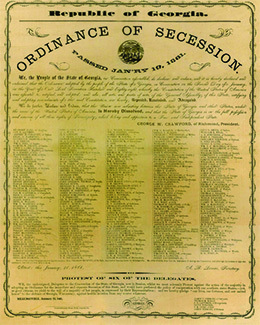| << Chapter < Page | Chapter >> Page > |

Explore the causes, battles, and aftermath of the Civil War at the interactive website offered by the National Parks Service.
The seven Deep South states that seceded quickly formed a new government. In the opinion of many Southern politicians, the federal Constitution that united the states as one nation was a contract by which individual states had agreed to be bound. However, they maintained, the states had not sacrificed their autonomy and could withdraw their consent to be controlled by the federal government. In their eyes, their actions were in keeping with the nature of the Constitution and the social contract theory of government that had influenced the founders of the American Republic.
The new nation formed by these men would not be a federal union, but a confederation. In a confederation, individual member states agree to unite under a central government for some purposes, such as defense, but to retain autonomy in other areas of government. In this way, states could protect themselves, and slavery, from interference by what they perceived to be an overbearing central government. The constitution of the Confederate States of America (CSA), or the Confederacy , drafted at a convention in Montgomery, Alabama, in February 1861, closely followed the 1787 Constitution. The only real difference between the two documents centered on slavery. The Confederate Constitution declared that the new nation existed to defend and perpetuate racial slavery, and the leadership of the slaveholding class. Specifically, the constitution protected the interstate slave trade, guaranteed that slavery would exist in any new territory gained by the Confederacy, and, perhaps most importantly, in Article One, Section Nine, declared that “No . . . law impairing or denying the right of property in negro slaves shall be passed.” Beyond its focus on slavery, the Confederate Constitution resembled the 1787 U.S. Constitution. It allowed for a Congress composed of two chambers, a judicial branch, and an executive branch with a president to serve for six years.
The convention delegates chose Jefferson Davis of Mississippi to lead the new provisional government as president and Alexander Stephens of Georgia to serve as vice president until elections could be held in the spring and fall of 1861. By that time, four new states—Virginia, Arkansas, Tennessee, and North Carolina—had joined the CSA. As 1861 progressed, the Confederacy claimed Missouri and Kentucky, even though no ordinance of secession had been approved in those states. Southern nationalism ran high, and the Confederacy, buoyed by its sense of purpose, hoped that their new nation would achieve eminence in the world.
By the time Lincoln reached Washington, DC, in February 1861, the CSA had already been established. The new president confronted an unprecedented crisis. A conference held that month with delegates from the Southern states failed to secure a promise of peace or to restore the Union. On inauguration day, March 4, 1861, the new president repeated his views on slavery: “I have no purpose, directly or indirectly, to interfere with the institution of slavery in the States where it exists. I believe I have no lawful right to do so, and I have no inclination to do so.” His recognition of slavery in the South did nothing to mollify slaveholders, however, because Lincoln also pledged to keep slavery from expanding into the new western territories. Furthermore, in his inaugural address, Lincoln made clear his commitment to maintaining federal power against the secessionists working to destroy it. Lincoln declared that the Union could not be dissolved by individual state actions, and, therefore, secession was unconstitutional.

Notification Switch
Would you like to follow the 'U.s. history' conversation and receive update notifications?